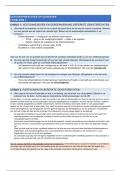Samenvatting
Summary Pharmaceutical Pricing and market access, readings summaries and learning goals
- Instelling
- Erasmus Universiteit Rotterdam (EUR)
This document includes summaries for each required reading of the course: "Pharmaceutical pricing and market access" GW4575M . It also includes the learning goals for each week with the main points made in the working groups. Each article is summarized separately.
[Meer zien]













